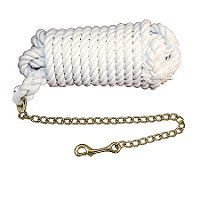Horse leads come in various lengths, diameters, materials and buckle-types.
If you can’t keep track of leads for routine ranch work, try an inexpensive lead made of cotton, 5/8″ diameter, at least 10′ long. It is comfortable on the hand and easy to grip, and you can keep several around the ranch and barn for quick access.
My favorite routine ranch lead is a versatile and comfortable 14′ poly training lead. They are always useful, inexpensive and you can keep two or three.
Shop 14′ poly training rope

However, for the ultimate lead, a rope made of heavy yachting/marine rope, 14′ or 15′ long is great for absolutely everything from leading to line-lunging. I can cost up to $50 but will be your cherished rope for years. You wil probably have to order from Clinton Anderson or Pat Parelli.
Popper: The two small pieces of leather found at the end of some training ropes are called Poppers. They are used to “tap” a horse from a distance. While not usually dangerous or damaging, a popper can get your horse’s attention quickly and can direct his attention to the area that is tapped.
 Lead Shanks are sometimes called “stud chains”. Some lead lines have a chain (usually between 18″ and 30″) attached to the lead with a snap end. It is often wrapped over a horse’s nose threaded through the halter rings. It puts pressure on the sensitive parts of the horse’s face, making the animal more aware of the handler’s signals. By wrapping or threading the chain in various ways through a halter (such as over the horse’s nose or under the chin) the chain transmits more powerful and more meaningful corrections to the horse. Also called a “stallion chain”. It gives a handler more leverage to handle a difficult horse. It is sometimes seen in the show ring because it allows a handler to communicate more subtly with a horse under lead.
Lead Shanks are sometimes called “stud chains”. Some lead lines have a chain (usually between 18″ and 30″) attached to the lead with a snap end. It is often wrapped over a horse’s nose threaded through the halter rings. It puts pressure on the sensitive parts of the horse’s face, making the animal more aware of the handler’s signals. By wrapping or threading the chain in various ways through a halter (such as over the horse’s nose or under the chin) the chain transmits more powerful and more meaningful corrections to the horse. Also called a “stallion chain”. It gives a handler more leverage to handle a difficult horse. It is sometimes seen in the show ring because it allows a handler to communicate more subtly with a horse under lead.
It can be used over the nose, under the chin, through the mouth (mouth chaining is most severe and universally discouraged).
The handler does not hold the chain directly. It would be very uncomfortable and could cause hand damage. If it is used too harshly, it can damage the horse’s nose. By the same token, jerky or severe handling of the lead with a shank chain can also cause pain or cause a horse to become frightened or rear.

Is it safe to wrap just the lead rope around the horses chin and face after running it through the halter. The horse is from a wild herd and not domestic. The horse is 1 year old and not broken.I’ve heard it can damage the nasal passage and is painful.
Hi Steve:
I am not sure about the mechanics of your make-shift control loop. You say you want to wrap it “through the halter”, which implies you can get a halter on the horse. I am assuming you are using a flat web halter, which affords zero safe control and should be reserved for trained horses. The whole point would be moot if you put a clinician’s 4-knot rope halter on him instead. It will give you significantly more control and quickly teach him to give to pressure and not fight leading. Read about halters here: https://horse-pros.com/5780/halters
Then start through the Horse Training Exercises here: https://horse-pros.com/5513/horse-training-exercises-a-good-start
You are in a perfect position to start a young horse who has no bad habits yet. Much easier than working with one that is already “ruined”. Either work along with us in this blog, one step at a time down through the “Horse Training Exercises”, or find Clinton Anderson or Pat Parelli training dvd’s to take you through the systematic steps. By the time your horse is ready to mount, he will be like a well-trained circus pony – the envy of everyone with a problem horse.